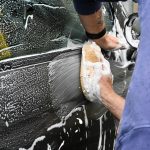Essential Tips for All-Season Tire Care: Keep Your Ride Safe Year-Round
Spring Car Care Essentials
Spring is the perfect time to inspect tires after the harsh winter months. It’s vital to check for any cracks or deformities caused by cold weather. Cleaning tires and wheels to remove any salt and grime buildup prevents corrosion and maintains tire integrity.
Aligning the wheels ensures smooth driving and improves vehicle performance. Checking the suspension and ensuring proper tire balance also enhances safety. Opting for all-season tires that offer good traction in wet conditions can help tackle the spring rains effectively.
Winter Preparation with Tires
Winter requires careful preparation to manage snowy and icy road conditions. Switching to winter tires is recommended as they have better grip at low temperatures. These tires are designed with softer rubber compounds that stay flexible and provide better traction on snow and ice.
Keeping tires properly inflated during winter is crucial, as cold air reduces tire pressure. It is essential to regularly check tire pressure to ensure stability when driving. Storing summer or all-season tires properly in a cool, dry place prolongs their life, ready for when warmer weather returns.
It’s wise to also inspect the vehicle’s tire chains or traction aids if they are regularly used. Ensuring their functionality can help maintain control and enhance safety in slippery conditions.
Maximizing Safety Through Brake Inspection

Brake inspection plays a critical role in ensuring vehicle safety throughout the year. Regular checks can help identify worn parts and prevent accidents caused by brake failure.
Brake Safety Awareness
Keeping brakes in optimal condition is essential. Routine inspections should include checking the brake pads, rotors, calipers, and brake fluid for signs of wear or damage. It is recommended to check brake components at least twice a year and especially during Brake Safety Awareness Month.
Drivers should be educated on the signs of brake issues, such as squealing noises or a spongy pedal. Early detection of such problems can prevent more significant issues from arising and ensure the vehicle remains safe to drive.
Monitoring and Maintenance of Vehicle Performance
Regular vehicle performance monitoring and maintenance play a crucial role in ensuring safety and longevity. Key aspects include checking engine light indicators and understanding the role of O2 sensors in engine efficiency and emission control.
Checking Engine Light Indicators
The check engine light is a significant diagnostic tool, found on the dashboard, designed to alert drivers to potential issues. When this light illuminates, it indicates that the vehicle’s onboard diagnostics system has detected a problem. Ignoring this warning can lead to more extensive vehicle repairs in the future.
It’s essential to address these warnings promptly. A diagnostic tool can identify specific codes related to the issue, allowing mechanics to determine the necessary repairs. Common causes for the light include issues with the fuel system, catalytic converter, or ignition system. Timely intervention can prevent further damage and ensure the vehicle maintains its performance and efficiency.
The Role of O2 Sensors
O2 sensors are integral to maintaining vehicle performance and emission standards. These sensors measure the oxygen levels in the exhaust gases, ensuring the engine is operating efficiently. A faulty O2 sensor can lead to poor fuel economy, increased emissions, and, eventually, engine damage.
Replacing or repairing a problematic O2 sensor promptly can restore the balance in the air-fuel mixture, improving fuel efficiency. Modern vehicles often come equipped with multiple O2 sensors to fine-tune emissions, highlighting the importance of routine checks. Regular monitoring of these sensors assists in maintaining the vehicle’s environmental compliance and extending the engine’s lifespan.



